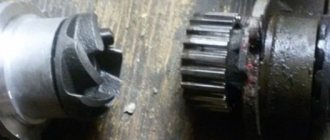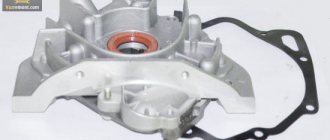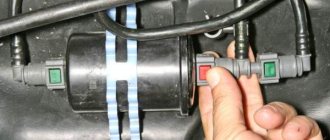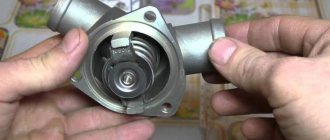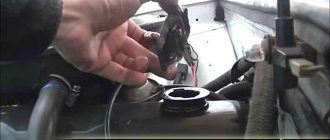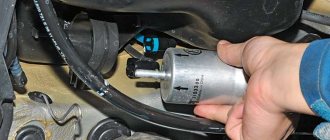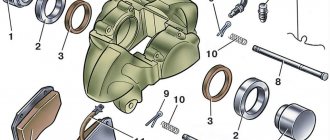Causes of malfunction
The water pump of Priora engines is a very unreliable element, so it is not recommended to neglect replacing it when changing the belt; it is better to change the complete set.
So, let's talk about the main malfunctions of the pump, in which it must be replaced:
- Flow. The water pump has a special hole to drain coolant if the seal is not tight. Over time, the sealing gland on the shaft under the influence of high temperatures becomes less elastic and begins to leak coolant. You can detect leaks by looking under the timing cover.
- Bearing wear. With such problems, the pump begins to squeak and rattle very much on a cold engine; as the engine warms up, these symptoms may disappear. It is difficult to determine this problem without removing the belt and can easily be confused with worn out rollers.
- Impeller. When the impeller breaks or rotates, the circulation of coolant in the car is disrupted, therefore, the car engine begins to overheat, which can lead to high costs for its repair.
- Wedge. The most terrible and unpleasant pump failure. The wedge of the pump is necessarily accompanied by a broken timing belt and, consequently, bending of the valves, which is quite expensive when carrying out repairs.
Review of water pumps for Lada
- /
08/11/2015 There are currently a variety of brands and manufacturers of water pumps on the market; each manufacturer claims that its products are the best.
In addition, when the pump fails, the cooling of the car sometimes worsens, which automatically leads to increased overheating.
We will try to impartially figure out what’s what, and consider one of the most popular items - a pump for front-wheel drive eight-valve VAZ cars. To avoid any confusion, let's clear things up right away. Eight-valve engines on front-wheel drive VAZs were constantly modernized and changed, so the pumps listed below are suitable for all engines equipped with the so-called “eighth” timing belt.
If we take it by model, then these are VAZ 2108, 2109, 21099, 2110, 21013, 21014, 21015, as well as Kalinas and Prioras of the first years of production. We purchased seven samples of pumps from different manufacturers - both domestic and foreign.
But before we start introducing the products, I would like to explain some of the terms that are used below. The impeller is a low impeller, which is located on the reverse side of the main impeller, its purpose is to relieve the shaft-housing seal.
Equally important is the presence of holes in the base of the impeller - they also help reduce the load on the mechanical shaft seal with the housing.
A ball roller bearing is a bearing that has balls on one side and rollers on the other. Such a bearing can carry greater loads than a double-row ball bearing.
Replacing the pump
The process of replacing or diagnosing the pump is carried out after removing the timing belt; you can read how to remove or replace the timing belt here.
Required tool:
- Ratchet and extension;
- Head for “10”, “15”, “17” mm;
- TORX T30;
- Sealant;
Step-by-step instruction
- If, during the process of replacing the timing belt and diagnosing the coolant pump, faults are discovered in the pump, then it must be replaced.
- The pump is replaced after removing the timing belt.
- Before removing the belt, it is recommended to unscrew the camshaft pulleys, since it is much more difficult to do this with the belt removed.
- Do not confuse the location of the pulleys. The intake pulley has a ring inside for operation of the phase sensor.
- Next, you need to drain the coolant.
- Using the key to “13”, unscrew the plug in the cylinder block and pour the Antifreeze into a container with a volume of 5-10 liters.
- We dismantle the tension roller mounting bracket.
- We unscrew the plastic base of the timing cover with a 10mm head and remove it.
- Unscrew the three bolts securing the pump and remove it.
- Before installing a new pump, we clean the surface from dirt to avoid distortion of the pump, which can lead to misalignment of the timing elements and damage to the belt.
We install the new coolant pump in the reverse order of installing the timing belt.
The work process is completed. We hope our article was useful to you.
Which pump is better to choose for a 16-valve VAZ 2112?
- Gates
- Manufacturer: Republic of Belarus.
- HEPU
- WEEN
- The pump from the manufacturer FENOX is one of the cheapest on the market.
- TZA
- Retail price: 300-350 rubles.
- Luzar
- FENOX
- » » » Today we will tell you how to choose the right coolant pump, what to look for, and find out what experienced VAZ-2112 owners advise. After diagnosing various forums, we compiled a rating of all pumps that are popular among VAZ-2112 car enthusiasts and compiled a rating that can fully reveal all the advantages and disadvantages of each model. The video explains how to distinguish an original pump from a fake, and what to look for when choosing this part: Previously, we wrote about how to check the performance and how Contents Signs of a fake pump. This is clearly not the famous Gates. That's why we didn't include it in our rating, there are too many fakes. Pumps are produced with six and seven blades; they differ in manufacturer and technical characteristics. According to various tests carried out, those models with seven blades perform much better during operation than its limited counterpart. Below we will present you with a rating of the five best pumps, the performance of which varies in the same range. Which pump is better to choose for a 16-valve VAZ-2112?
- FENOX
WEEN
- HEPU
- Luzar
- TZA
- Gates
Loading .
FENOX pump
- Manufacturer: Republic of Belarus.
- Retail price: 300-350 rubles.
- The pump from the manufacturer FENOX is one of the cheapest on the market.
Malfunctions
Water pump for car
The causes of failure can be different, for example, bearing jamming or the formation of play. Sometimes it happens that the impeller begins to spin freely, but separately from the shaft. The pump also needs to be replaced if it leaks or becomes noisy.
Life time. A lot depends on the quality of the pump. For example, a low-quality and defective pump can last only 10-15 thousand km. The service life of a high-quality part is when the Priora runs 100 thousand km. and more.
The manufacturer installs a pump on the Priora, produced by the Russian enterprise Togliatti Automotive Units Plant (TZA). It has a long service life.
Unfortunately, recently sales of counterfeit pumps from TZA have become more frequent. Is it possible to distinguish a fake so that your Priora does not suffer?
A high-quality box should contain a pump, inside the box there should be a warranty card with stamps and the date of manufacture and a gasket. It is mandatory to have a holographic sticker on the pump.
The best brands of water pumps for Lada Priora
Among manufacturers of pumps for Priora, car owners give preference to the TZA and LUZAR brands. The first one produces original parts for the Lada, and many buyers want to see exactly these on their car. And the second brand is considered one of the most reliable. The choice of manufacturers is quite large, and each has advantages.
TZA plant
Since its founding, it has been supplying parts to the AvtoVAZ assembly line. For Priora, he offers models with an 8-blade impeller, which increases the efficiency of heat removal.
Spanish pumps DOLZ
, which correspond to the original in all respects, cope with their tasks perfectly and are not capricious in relation to antifreeze.
Water pumps LUZAR
capable of operating at high speed for a long time. And the manufacturer gives them a 2-year warranty.
Pumps produced under the LADA brand –
original parts demonstrating optimal compatibility with vehicle components and high performance.
And the German brand FINWHALE
famous for the performance and extended life of the pumps.
How is the pump replaced on a Priora?
Replacing the Priora water pump. Warning! Do not turn the crankshaft or camshaft after the camshaft drive belt has been removed, otherwise the piston may hit the valves. Wear of the pump bearing (indicated by increased noise during operation) and leakage of coolant from the pump are the main defects of the water pump.
As a rule, repairing the water pump does not lead to the desired result, so it is recommended to replace the pump assembly. Replacing the pump is a procedure for performing actions that you can do yourself.
Description
| STEP # | |
| 1 | You need to disconnect the wire from the negative terminal of the battery. |
| 2 | Next, you should drain the coolant. |
| 3 | Then the piston of the first cylinder is set to the top dead center position. |
| 4 | Then the tension roller is removed. |
| 5 | The camshaft toothed pulley is removed behind the tension roller. |
| 6 | It is necessary to unscrew the 4 bolts and the fastening nut and start removing the rear cover of the camshaft drive belt. |
| 7 | Insert a screwdriver into the groove, carefully separate the pump from the block and remove it. |
| 8 | Then you need to remove the gasket from the pump. If it is damaged, it needs to be replaced. |
| 9 | Then, if the coolant leaks through the drain hole, then you need to replace the water pump (if the seal is damaged). |
| 10 | If the pump shaft exhibits noticeable axial play (or the bearing is damaged), replacement is also required. |
| 11 | If chips, cracks, or chipping are found on the toothed pulley, impeller and pump housing, it is also replaced. |
| 12 | You need to check the tightness of the pump bearing locking screw. The screw must be tightened if necessary. |
| 13 | Next, you need to install the pump in the reverse order of removal. In this case, the number on the part must be directed upward. |
| 14 | And finally, you need to install the remaining parts in the reverse order of removal. |
The original or the Chinese equivalent is half the price: we disassemble and compare water pumps
A little history
Let’s start with a short reminder of what a pump (or water pump) is, why it’s “watery” if there’s been antifreeze splashing in the cooling system for a long time, and why it sometimes has to be changed. At the very beginning of the existence of cars, the cooling system was elementary - open. And there were no pumps there, the system was a thermosiphon: hot water, according to all the laws of physics, rose to the top, cold water flowed down, all this slowly circulated, and everyone was happy. We were happy, but not very happy, because the water consumption was enormous. Due to the fact that water was simply poured into an open tank, it evaporated very actively. Therefore, a logical step was taken: to make the water cooling system closed. The water in it cannot evaporate quickly, which means it does not need to be constantly topped up. And it was also necessary to invent a radiator, because the conventional coil, which was used at the very end of the 19th century, was not efficient enough. At first, he coped with his work in a closed system, but complaints against him remained. Moreover, the system remained a thermosiphon system - without a water pump. Only at the very beginning of the 20th century did the very detail appear that gave the system an almost modern look - the pump. She is also a water pump. The task of the water pump was not difficult, but very important: to drive water inside a closed loop. That’s why the pump was called a water pump, since there was nothing but water in the cooling systems at that time. And since in essence it is an ordinary pump (usually a centrifugal one), the name remains the same: water pump. I'll call it a pump for short. Over time, pumps have become more diverse. Some have “learned” to listen to ECU commands, but most budget cars with simple engines still drive with rather primitive pumps. As a rule, they are quite enough.
What and how?
So, the task of the pump is clear to us: to force the coolant to circulate in the cooling system. It does this quite simply: the impeller drives the flow of antifreeze from the radiator to the block. The drive of the pump can be different, but the most popular is a belt. Most often - by the timing belt, but sometimes it is turned by the serpentine belt of additional units. In theory, this is a fairly reliable unit. But still, it has to be changed periodically. Like any other mechanism with seals and bearings, it wears out over time. At best, the pump begins to leak a little, at worst... There are different options. Wear of the bearings first leads to an unpleasant squeaking noise, which is most often very audible on a cold engine, but disappears as it warms up. If you do not respond to it in any way, the pump may jam. And this is already sad, because if the pump is driven by a timing belt, the latter usually cuts off the teeth, which often leads to valves and pistons meeting on “plug-in” engines. If the pump is driven by a belt of additional units, the consequences can also be bad. For example, it happens that due to the pump jamming, the engine simply stalls at idle - it grabs it too hard by the belt, which, of course, is rotated by the crankshaft pulley. It’s especially disappointing that computer diagnostics in this case will not show anything: there are no errors in the engine, its systems or sensors. And he still stalls. Another unpleasant failure scenario is the failure of the impeller blades. This happens for various reasons. If the blades are metal, they will corrode over time. True, car owners are often to blame for this process because they forget that antifreeze needs to be replaced at least once a decade and there is no point in pouring slurry into the cooling system, which is sold on the market “brotherly” for a hundred rubles. A healthy antifreeze means a healthy pump, so to speak. Plastic impellers simply wear out. And if they are made by the playful hands of a huckster from an underground workshop, they wear out very quickly, causing bewilderment to the car owner who has just installed such a pump. If the impeller wears out, the symptoms of failure will be as if there is no pump at all: the motor gets hot, and in advanced cases it can even “steam”. To make sure that it is the pump that is to blame, a method that has become popular among VAZ owners is suitable: on a warm engine, pinch the pipe coming from the radiator with your hand. If there is no pressure in it, the pump is dead. For other breakdowns there will be more work. You'll have to at least inspect the pump. If it is in antifreeze, it will also have to be replaced. In addition, you need to make sure that it is level. If the bearings in it have already died, the pulley may be slightly misaligned. The same thing happens if some not very decent craftsman stuck a new pump to a dirty mating surface. Unfortunately, in our imperfect world, where Feduk sings and Kristina Asmus stars, such things happen regularly. By the way, if the pump is leaking, you can smell antifreeze. It is so specifically sweet that it is impossible not to recognize it. Before disassembling the pumps and looking at their insides, I’ll say one more thing: pumps often die due to all sorts of stop leaks that are poured into cars with leaky radiators. Risk is, of course, a noble thing, but not always reasonable.
Three from the casket
There are three pumps in front of us. Just out of curiosity, we took these: the original pump from AvtoVAZ (21120130701082), the little-known G-Part product (2112-1307010) and the most affordable Chinese pump from Gallant. All of them are suitable for VAZ 2110, 2111 and 2112 with a 16-valve engine. Let's see what these pumps are. Let's start with the original. After all, this should be the standard, and all other pumps should be the envy of it.
I won’t discuss the box – the box is just a box, nothing interesting. Let's move straight to the pump.
If you don't look closely, there is nothing strange about it. The impeller, by the way, is plastic.
If you start looking more closely, there are some comments. Firstly, it was still not done very carefully. For example, there are burrs sticking out everywhere on the chamfers. However, this, as they say, “does not affect the speed,” and you shouldn’t find fault with it.
But the second remark is very significant. Gentlemen, you can’t do the pulley that drives the timing belt like that!
I wonder if you buy ten VAZ pumps, will this defect be repeated on at least one more? I hope not, but seeing this on an original part is a little painful. Well, let's take it apart.
Let's start by removing the shaft bearing retaining screw. This requires a hexagon, but there is nothing complicated in the process itself.
Then the pump is also very easy to disassemble. Using a puller, we pull off the pulley, then with the same puller we easily squeeze the shaft towards the impeller. There is no additional fixation of the pulley and bearing, so anyone (who has a puller) can do it. As a result, we get a separate housing, pulley and shaft with a bearing and impeller.
The inside of the pump looks even better than the outside. Everything is quite neat. It’s good that the shaft bearing is fixed with a screw and not with sealant: it’s convenient to disassemble. True, it is not clear why to do this: if the pump dies, it is easier to install a new one than to try to repair the old one.
As you can see, there is nothing complicated inside the pump. And yet it sometimes requires replacement. It is impossible to estimate the bearing life by eye, but you can say something about the original pump.
The advantages include a high-quality case that easily survived disassembly, ease of disassembly itself, and generally good quality of surface treatment that requires it. The disadvantages are a rather obscene attitude towards those surfaces that are not adjacent. They just had a bolt hammered into them. This is probably the result of finding a compromise between price and quality, so there’s nothing to complain about either. This approach is acceptable. But knocked down edges of a pulley gear are a serious problem. It will certainly affect the life of the timing belt, because these strange notches not only change the relief of the tooth in height (which can be survived), but also protrude beyond the dimensions of the tooth in width. This means the belt will wear out. It is unacceptable. We can only hope that this marriage is an isolated incident. The second pump is the Chinese Gallant. A very funny product, to be honest.
It looks good from the outside. The impeller is metal.
The quality of processing also looks decent, although the ends of the pulley teeth are not processed very carefully.
Everything glitters and sparkles so that you can’t take your eyes off it. But let's try to take it apart.
It seems to be similar to the original, but it’s not. Let's look at the body.
It began to fall apart even at the stage of removing the pulley, although the puller does not touch the body at all during this process (it holds the pulley with its paws and presses into the shaft). As soon as I pressed the body in a vice a little, a piece fell off of it. “Perhaps I overdid it,” I thought. Just for fun, I took some pliers and... broke off another piece of the body. Then more. In general, I don’t know what this case is made of. Something like pressed foil.
Structurally, the pump also differs from the original. There is no screw that secures the shaft bearing. The shaft is sitting on some kind of blue sealant. And it sits very firmly. It is impossible to pull it out, as on a VAZ pump towards the impeller: a ledge is cast inside the body into which this shaft rests. Therefore, you first need to remove the impeller and push the shaft from the bearings towards the pulley. We broke the housing anyway, so we didn’t spare the pump and pressed out the shaft with a hydraulic press in the same way as on the VAZ pump. At the same time, the hull was broken, but there was nothing to lose.
The layer of sealant was not pleasing: in some places it was thick, in others it was empty.
The advantage of the pump is the cost. It cost us 772 rubles, but the original one cost 1,602 rubles. The difference is obvious.
The downside is the quality of the case, not very high-quality assembly. I could also add something about the inability to quickly disassemble it, but I won’t. This, as I said, is no longer relevant for a long time, and the pumps are replaced as a whole. The third pump is interesting because it is packaged under the g-part brand, which is still unknown to me. The box differs from the previous two at least in its higher quality printing and the fact that it is glossy. This has absolutely no effect on the quality of what’s inside, but I have a kind of warm relationship with glossy boxes. Probably in a past life I was a magpie and loved everything shiny. But it's not as interesting as a sticker with a part code. With its help, you can check the authenticity of the part on the g-part website. It's a small thing, but nice.
If the part is genuine, then it has a two-year warranty. Also good. But we are more interested in what lies inside.
And inside there is a regular pump. There are no questions about her appearance. The pump is very similar to the one we bought for 772 rubles: the workmanship is also of very good quality and the impeller is also metal.
The processing of the pulley teeth also does not raise any questions: there are no burrs, much less dents, as was the case on previous pumps.
Let's take it apart. Structurally, this pump is the same as the previous one: it is difficult to disassemble, and we only did it with the help of a press. You can also remove the shaft only towards the impeller, and not the pulley, as on the VAZ pump.
There is also no locking screw here, and all the parts just fit tightly. However, the housing turned out to be much stronger than the housing of the cheapest pump. They even completely disassembled it: they removed the pulley, the impeller, and the shaft with the bearing.
1 / 3
2 / 3
3 / 3
It’s even strange, but there are no questions about this pump at all. Despite its origin, its body turned out to be strong, and its assembly was quite decent. The puller and press left scratches on the body, of course, but nothing fell apart.
What's the result?
Of course, it is impossible to evaluate a part without a full life test. But even the minimum that we saw during disassembly of the pumps (and in the case of the VAZ pump, without disassembly, but directly on the pulley), allows us to draw some conclusions. Only one pump cannot get a positive rating - this is Gallant for 772 rubles. It breaks too easily with pliers. Maybe, of course, it will serve, but it doesn’t inspire confidence at all. True, it costs, I repeat, a penny. The original is good, but its reputation was greatly spoiled by the notches on the pulley teeth. Apparently, quality control is not the company's strong point. However, if you at least carefully inspect this pump before installation, there should be no problems. A significant disadvantage is the cost of 1,602 rubles, which is more than two times more than the first Chinese product. More precisely, a Chinese craft. I’ll go into a little more detail here. It is likely that this pump would have shown its best side in a resource test. But we all know about the “plug-in” nature of modern engines. So the timing belt is sacred to them. The pump started whistling - I replaced it and forgot about it. But if the belt breaks... In general, even an external examination allows us to draw some conclusions. The g-part pump is the golden mean. There seem to be no complaints about the quality: the body is durable, looks neat, and is well assembled. The kit, like previous samples, includes a gasket. The cost of the pump is 1082 rubles, which is noticeably more interesting than the VAZ part. Of course, I would like to check how it would behave in a bearing test, on which the life of the pump mainly depends, but, alas, today we have the wrong format. But if you try to evaluate the pump based on external parameters, then I would probably install this particular pump. Well, or the original, if I found a non-defective part.
Life hack: Priora car pump 16 valves
No driver expects his car to suddenly “boil.” This is one of the worst scenarios of the day - you will have to stop and cool the car. Rule out problems in advance - first of all, inspect the Priora pump. If the water pump of a Lada Priora car with a 16-valve engine fails, this will instantly extinguish all the car’s efforts to cool it. In addition, the timing assembly, rollers and pump break down - and this is a disaster for the engine because all these spare parts are dependent on each other. The supplied device works like a pump - it pumps up antifreeze and forces it to flow through the circuit at a certain speed, it manages to “release” the heat it receives from the engine. A pump replacement is needed when the Lada Priora pump breaks down, the coolant “stands up”, accumulating all the heat inside itself and releasing it to the surrounding air with less efficiency. That is why this device should not be allowed to malfunction.
Which pump for Lada Priora is better for 8 and 16 valves
» The pump is the most important element of any car, including Prioras.
It ensures coolant circulation, thereby avoiding overheating of the machine.
However, a number of problems can arise with the part. However, it cannot be repaired; if it fails, it will have to be replaced. However, every car enthusiast wants to install products from a good manufacturer on their car. Today we’ll talk about why a pump can break, how to choose one for a Priora and which one is better.
Standard part - article number, price
AvtoVAZ installed parts with the catalog name “Pump. Water pump" for Lada Priora 16 valves and number 2109-01307013-00. Price: about 2,000 rubles.
Operating principle of the device
The pump design is quite simple. It consists of the following parts:
- Frame;
- Bearing;
- Impeller;
- Stuffing box;
- Shaft;
- Cardboard spacer;
- Drive pulley hub;
- Pulley.
The timing belt smoothly rests on the device pulley, which clings to the teeth. When the engine starts, the camshaft starts moving, and then the belt begins to move. The pulley turns slowly, causing the shaft to move. The shaft, unwinding, transmits torsion to the impeller through a series of bearings and seals.
The impeller is installed between two tubes: the input flow comes from the radiator, and the output goes into the cooling jacket.
The part itself is a flat circle with applied arc-shaped “petals” that take up the liquid and throw it towards the cooling jacket. So, turning over and over again, they accelerate the flow of antifreeze inside the circuit.
Signs of a faulty water pump on a Priora
The water pump of a Lada Priora, like any other mechanism, will break sooner or later. To check the pump and reliably determine whether the part is faulty, pay attention to the following signs:
- Antifreeze is leaking - you can detect leaks by accident by seeing them on the ground under your car. They can also be detected by inspecting the engine cover. If coolant leaks out, the cooling system is not sealed. Not a single element can be discounted. The main suspects would be the pump and radiator.
- Coolant has to be added quite often. It is quite easy to notice that the coolant is leaking. It is much more difficult to notice light leaks that are invisible at first glance, but because of them you have to add antifreeze. Small cracks are formed precisely because of pump breakdowns.
- Extraneous noise - the pump whistles when the bearing wears too much. This does not happen simply due to the contact of metal parts. This bearing is a ball bearing, so when it wears out, the balls fly out, rubbing against the walls of the housing. This is how the whistling sound occurs when the pump is running.
- Rust - due to low-quality antifreeze, destruction processes are accelerated. Most often the impeller is hit - it comes into contact with the liquid. There is a way out - for example, install a plastic impeller. Even if the driver forgets to change the used antifreeze, nothing will happen to the impeller.
- Cavitation is a phenomenon that occurs when small vacuum areas form between the impeller blades. If the vacuum penetrates the device, a fairly serious bang, similar to an explosion, can occur. Its force can bend or even tear off a piece of metal, causing the device to jam.
- Resin deposits all come back to poor quality coolant. Some of the “dirt” settles on the impeller blades, reducing its efficiency: each time it takes less and less coolant to maintain a sufficient level of pressure inside the system. Increased levels of deposits will cause the part to stop completely.
- Normal wear and tear - Since each small component has its own life, this device also wears out. It is enough to examine it in detail: there should absolutely be no play.
What is the best pump for Priora?
The pump is the most important element of any car, including Prioras. It ensures coolant circulation, thereby avoiding overheating of the machine. However, a number of problems can arise with the part. However, it cannot be repaired; if it fails, it will have to be replaced.
However, every car enthusiast wants to install products from a good manufacturer on their car. Today we’ll talk about why a pump can break, how to choose one for a Priora and which one is better.
The pump consists of several elements that ensure its operation.
In particular: You can determine the malfunction of a part by ear.
Pay attention to noise from the timing belt.
If you hear a rumble, then the reason may lie in this element. Let's look at the main list of breakdowns:
Replacing the pump of a Lada Priora car
Replacing the pump in Lada Priora 16 valves is required when one of the signs of a malfunction appears. The exact replacement period is indicated - this is 100,000 km. However, there is advice to change it at the same time as the timing belt - once every 60,000 km.
Before replacing the Lada Priora device, place a basin under the car and drain the coolant through the plug. Pull the handbrake and get to work:
- Unscrew the screws securing the timing drive cover and remove the cover. Remove the belt along with the support rollers.
- If you have an air conditioner: Using a 10mm socket wrench, remove the mounting bolts that hold the accessory tensioner pulley in place. Remove the fastener.
- Using a 10mm socket wrench, unscrew the rear timing case cover bolts. Lift it up and then remove it.
- Using a “5” hexagon, unscrew the fastening screws. Pry it up with a flathead screwdriver and remove it. Unscrew the pulley bolt to disassemble the pump, replacing one of the spare parts. Install in the reverse order of removal.
When to change your pump
A clear sign that the pump needs to be replaced are the following points.
- In the warm season, there is frequent overheating of the power plant, although there is enough antifreeze in the expansion tank.
- Leaks appearing at the pump connections. Failure can be detected by fogging of the case or the presence of wet spots of a characteristic composition.
- Extraneous noise coming from the pump when the engine is running - it can be knocking, rustling or crackling.
- In winter, the heater stops working even when the engine is normally warmed up.
You should also consider the service life of the part on a particular vehicle. For most cars, the operating time of the device ranges from 60,000 to 90,000 kilometers. In some cars, this gap can reach 120,000 km. The manufacturer recommends replacing the pump before its service life expires.
Checking the pump without removing it
In some cases, you can check it without removing it: there are a number of faults that can be seen. To do this, discover the pump and then check each point:
- Backlash. If all the parts shake (or at least the pulley), then it’s time to change the part.
- Antifreeze leak. Inspect the device for signs of leaks. If they are not there, they must be elsewhere in the cooling system.
- Failure is also determined when the bearing whistles. This whistle is difficult to confuse with something: it either becomes louder or “fades away.” But keep in mind that a similar whistle can be caused by a broken generator.
How to replace the pump on a Lada Priora 16 valve car is shown in detail in this video:
Why do you need a pump?
If the information has reached an experienced motorist, you can safely skip this section. For beginners, before telling which pump is better to install on a VAZ, you should explain what it is and why it is needed.
The main task of the mechanism is to ensure proper circulation of antifreeze throughout the cooling system. If the design works correctly, the liquid maintains a stable temperature, and thermal shock due to sudden heating of the block when the speed increases is eliminated.
The pump also ensures normal operation of the stove. With good system circulation, the radiator quickly releases heat into the interior.
If the pump is missing, the motor will instantly overheat, which will cause its damage or complete destruction. A similar result occurs when it breaks.




